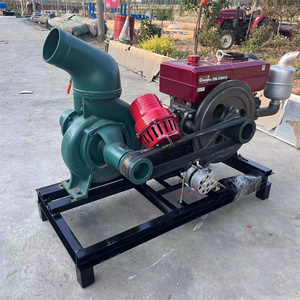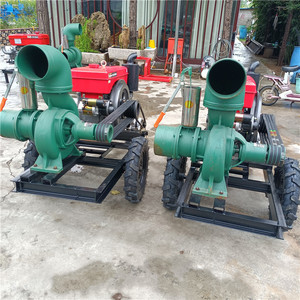(4894 products available)























































































































































































Pakistan irrigation systems can be classified into several categories based on their types and methods. The following are some key classifications:
Canal Irrigation:
This is the most common irrigation system in Pakistan. Water is drawn from rivers and fed into a network of canals. Farmers use this water to irrigate their fields. The canal irrigation system has been developed over a long time and is extensive, especially in Punjab and Sindh provinces.
Tubewell Irrigation:
Tubewells are vertical pipes with large diameters sunk deep into the ground to extract groundwater using pumps. There are two main types of tubewell irrigations: Indus Basin Irrigation System tubewells, which are part of the larger canal system, and private tubewells, which individual farmers build for their own use. Private tubewells have significantly increased the amount of land that can be irrigated.
Lift Irrigation:
In areas where irrigation water is available at a lower level than the fields, lift irrigation is used to raise water to the fields using mechanical devices such as diesel or electricity-powered lift pumps. This method is commonly applied for canal water and in tubewells to transport groundwater up to the desired level.
Flood Irrigation:
This method is mainly utilized for crops like sugarcane and rice that require large amounts of water. Water is allowed to overflow into fields from canals and let it spread naturally across the entire field. Farmers create small bunds (dikes) along field borders to control water flow and keep it flooded long enough for plants to absorb enough moisture.
Drip Irrigation:
Drip irrigation systems deliver water directly to the roots of plants through a network of tubes, pipes, and emitters. This method is highly efficient and conserves water, making it ideal for high-value crops and areas with water scarcity. Drip irrigation minimizes water loss due to evaporation and allows precise control of water for individual plants.
Sprinkler Irrigation:
In sprinkler irrigation, water is pumped into pipes and sprayed over crops through a system of sprinklers, resembling natural rainfall. This method is suitable for various terrains and is efficient in water use. There are different types of sprinklers, such as stationary, revolving, and portable, each suitable for different crops and field sizes.
Water Conservation Irrigation:
Due to limited water resources, irrigation methods that conserve water are gaining importance. These include rainwater harvesting systems, where rainwater is collected and stored for agricultural use, and watershed management, which involves protecting and managing natural watersheds to optimize water availability for irrigation.
The design of Pakistan's irrigation system is remarkable. It can be traced back to the Indus Valley Civilization, which laid the foundation for the country's present irrigation systems. This ancient civilization built extensive canal networks to divert water from the Indus River and its tributaries for agriculture. The main features of this design are as follows:
Canal irrigation
Pakistan's canal irrigation system is mostly used in Punjab and Sindh for the cultivation of wheat, rice, and cotton. For instance, farmers in Punjab depend on the canal system to irrigate their fields of wheat, which is planted in winter and requires a steady water supply during its growing season. The canals also play a critical role in the Sindh province, where rice is grown, as paddy fields need water flow repaid to establish transplanted rice.
Tube well irrigation
In areas with inadequate rainfall and where groundwater is the only water source, like in southern Punjab or Thar Desert region, tube well irrigation has become essential. Tube wells are used to draw up groundwater for irrigation purposes. During dry months, when crops such as sugarcane in southern Punjab or millet in Thar Desert need more water, tube wells come in handy for irrigating these water-demanding crops.
Drip irrigation
Drip irrigation is increasingly being adopted in horticulture and high-value cash crop production under water-scarce conditions. For example, grape farmers in Balochistan province have installed drip systems that deliver water drop by drop directly to the roots of each vine. This technique saves water significantly and is very useful for the cultivation of grapes, which require a consistent but limited amount of water.
Sprinkler irrigation
Sprinkler irrigation is applied in fruit orchards and vegetable fields. For instance, in Khyber Pakhtunkhwa, where apples, peaches, and tomatoes are grown, many farmers use sprinkler systems to irrigate their lands. This method is also suitable for areas with uneven topography and where traditional canal systems cannot reach. During the critical growing period for fruits and vegetables, when water is essential, the sprinklers spray water over the fields like rainfall.
Purpose and Scale:
Determine the main purpose of the irrigation system. Is it for small-scale farming, large agricultural fields, landscaping, or gardening? The scale and purpose will influence the type of irrigation system needed.
Water Source and Availability:
Consider the water source and availability. What can be the sources of water? For instance, tube wells, canals, ponds, or rainwater collection? Evaluate the water quality, quantity, and consistency, as it will affect the irrigation system design.
Soil and Crop Considerations:
Analyze the soil type and its water-holding capacity. Different soils have varying irrigation needs. Also, consider the crops or plants being irrigated, as some may require specific irrigation methods.
Climate and Weather:
Consider the climate and weather patterns in the area. For example, the temperature, humidity, and rainfall affect irrigation scheduling and water requirements.
Budget and Costs:
Establish a budget for the irrigation system. Consider the initial installation costs, maintenance expenses, and potential long-term savings. It's crucial to find a balance between affordability and quality.
Ease of Use and Maintenance:
Opt for an irrigation system that is easy to use and maintain. Complicated systems may lead to errors and increased maintenance efforts. Look for user-friendly features and accessible maintenance requirements.
Flexibility and Adaptability:
Choose an irrigation system that can adapt to changing needs. For example, as crops rotate or as water sources fluctuate due to climate change. Flexible systems can be expanded or modified as needed.
Regional Practices and Recommendations:
Seek advice from local experts and consider regional practices. Understand the common irrigation methods used in the area and the recommendations from agricultural extension services or irrigation specialists.
Q1: What are the benefits of using Pakistan's irrigation systems?
A1: The benefits of Pakistani irrigation systems include efficient water supply, enhanced agricultural productivity, flood control, drought resilience, and sustainable water management.
Q2: What types of irrigation systems are commonly used in Pakistan?
A2: The commonly used irrigation systems in Pakistan include canal-based, tube well-based, sprinkler, drip, and flood irrigation systems.
Q3: How does the canal-based irrigation system work?
A3: The canal-based irrigation system supplies water through a network of canals from rivers, serving about 90% of Pakistan's irrigated land.
Q4: What role do tube wells play in irrigation?
A4: Tube wells lift groundwater to the surface using pumps, essential where surface water is scarce, and help combat groundwater depletion.
Q5: How does sprinkler irrigation save water?
A5: Sprinkler irrigation mimics natural rainfall and reduces water wastage, ideal for areas with water scarcity or unsuitable for traditional methods.
The web search volume for the keyword "pakistan irrigation" shows an average monthly search count of 30, with notable fluctuations over the past year. Despite a zero percent change in the last three months, the keyword experienced a -25% one-year change, indicating a recent decline in interest.
Analyzing the monthly data, we observe varied web search volumes with peaks and valleys corresponding to specific months. For example, the web search volume reached its highest at 50 in June 2024 and its lowest at 20 in July and August 2024. This pattern suggests seasonal variations, with peaks typically occurring in mid-year and lows in late summer. The data also shows that the web search volume tends to stabilize back to the average of 30 web searches by the onset of autumn, maintaining consistency through winter and into spring.
The fluctuations in web search volume for "pakistan irrigation" could be influenced by several factors, including agricultural cycles, weather patterns, and government policies related to water management and agricultural support in Pakistan. These elements likely drive the peaks and valleys observed in the search trends, reflecting the dynamic nature of the keyword within the Home & Garden category.